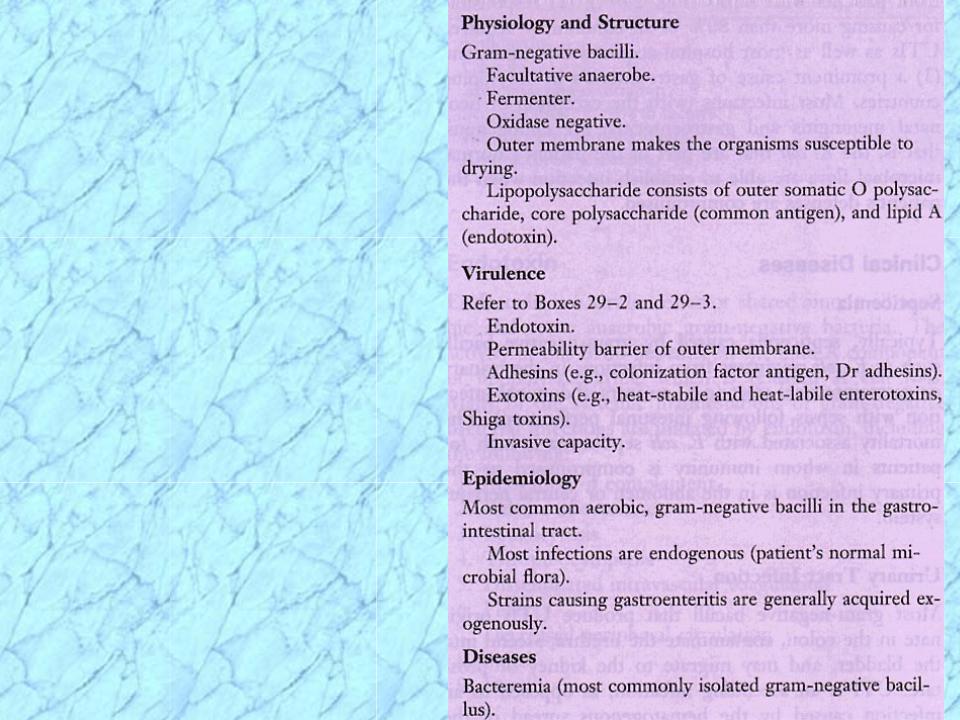
- •Opportunistic
- •OPPORTUNISTIC INFECTIONS OF
- •OPPORTUNISTIC INFECTIONS (cont.)
- •OPPORTUNISTIC INFECTIONS (cont.)
- •OPPORTUNISTIC INFECTIONS (cont.)
- •OPPORTUNISTIC INFECTIONS (cont.)
- •Virulence Factors Associated with
- •Endotoxin-Mediated Toxicity
- •See Handout on
- •Summary of Escherichia coli Infections
- •Summary of Escherichia coli
- •Gastroenteritis Caused by E. coli
- •Specialized Virulence Factors
- •Fimbriated
- •Afimbriated
- •Fimbriated
- •Heparin-binding epidermal growth factor on heart & nerve surfaces
- •REVIEW
- •OPPORTUNISTIC INFECTIONS OF
- •Virulence Factors Associated with
- •See Handout on
- •Endotoxin-Mediated Toxicity
- •Summary of Escherichia coli Infections
- •Summary of Escherichia coli
- •Gastroenteritis Caused by E. coli
- •Fimbriated
- •Afimbriated
- •Fimbriated
- •Heparin-binding epidermal growth factor on heart & nerve surfaces


Opportunistic
Enterobacteriaceae

OPPORTUNISTIC INFECTIONS OF
ENTEROBACTERIACEAE
GRAM NEGATIVE SEPSISURINARY TRACT INFECTIONSPNEUMONIA
ABDOMINAL SEPSISMENINGITIS
SPONTANEOUS BACTERIAL PERITONITIS
ENDOCARDITIS

OPPORTUNISTIC INFECTIONS (cont.)
GRAM NEGATIVE SEPSIS
Life-threateningUsually nosocomial
Commonly caused by E. coli
PATHOGENESIS:
Early Phase (REVERSIBLE)
Decreased arterial resistance; Increased cardiac output
Kinins (protein vasodilators & mediators of inflammation) in plasma due to tissue damage, endotoxin, AG-AB complexes
Second Phase (REVERSIBLE)
Increased arterial resistance; Decreased cardiac output
Third Phase (IRREVERSIBLE)
Vascular collapse with organ failure
Endotoxin induced DIC, hemorrhage and death

OPPORTUNISTIC INFECTIONS (cont.)
URINARY TRACT INFECTIONS
Usually ascending infection, not hematogenous route
Greatest incidence in young & middle-aged females
Incidence increases with age in males
Most commonly caused by E. coli
Diagnosis by microscopic & cultural exam of urine
Obtain urine by catheter through urethra into bladder, clean catch midstream (CCMS) or suprapubic tap
PNEUMONIA
Nosocomial; Spread by personnel and equipment
Frequently caused by K. pneumoniae
Often in middle-aged males who abuse alcohol
Difficult to diagnose due to commensals in sputum

OPPORTUNISTIC INFECTIONS (cont.)
ABDOMINAL SEPSIS
Caused by flora of the GI tract
Infections usually polymicrobial
MENINGITIS
Usually nosocomial
Frequently caused by E. coli
Diagnosis by microscopic & cultural exam of CSF

OPPORTUNISTIC INFECTIONS (cont.)
SPONTANEOUS BACTERIAL PERITONITIS
Usually in patients with liver ailments
Commonly caused by E. coli, but also anaerobes
& Gram-positive cocci (S. pneumoniae)
ENDOCARDITIS
Vascular endocardial surface inflammation
Mostly caused by Gram-positive cocci, but 1-3% caused by aerobic Gram-negative rods
Diagnosis by blood culture
Difficult to treat; Treatment is of long duration

Virulence Factors Associated with
Enterobacteriaceae
Common Virulence Factors
EndotoxinCapsule
Antigenic phase variationSequestration of growth factorsResistance to serum killingAntimicrobial resistance
Factors Associated with Specific Pathogens
Exotoxin productionExpression of adhesion factors
Intracellular survival and multiplication

Endotoxin-Mediated Toxicity
Fever
Leukopenia (reduced # of WBCs) (<5000/mm3) followed by leukocytosis (increased # of
WBCs)(>10-12,000/mm3)
Activation of complement
Thrombocytopenia (reduced # of platelets)
DIC (Disseminated intravascular coagulation)
Decreased peripheral circulation and perfusion
(blood flow) to major organs
Shock
Death

See Handout on
Enterobacteriaceae General Information

